Businesses today need to stay ahead in the digital world. Working with a top Google Ads agency can make a big difference. They offer expert help, detailed campaign work, and clear results. But, figuring out the different pricing models can be tough.
Table of Contents
In this article, we’ll look at the various Google Ads agency pricing models. We’ll talk about their good points and how to pick the right one for your business.
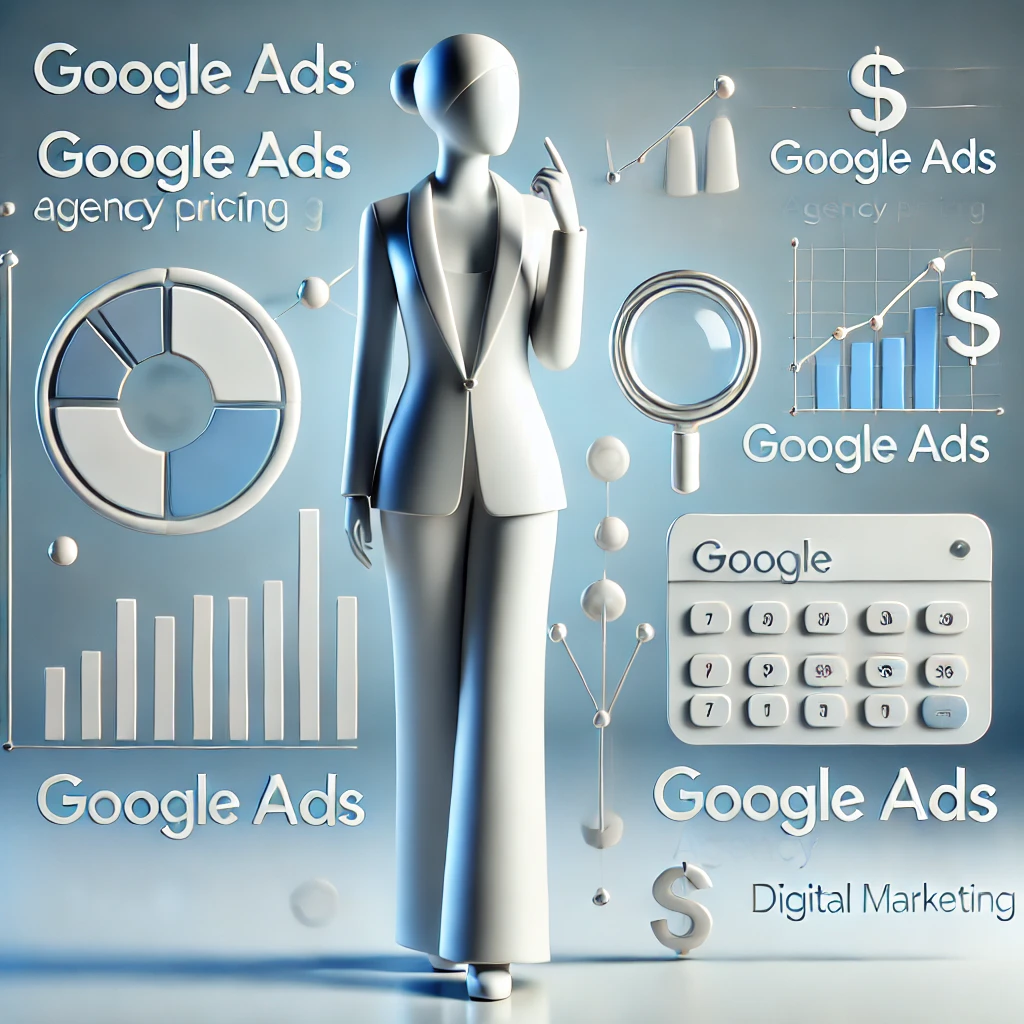
Key Takeaways
- Learn about the different Google Ads agency pricing models, like a percentage of ad spend, fixed fees, and performance-based ones.
- See the pros and cons of each to find the best match for your business goals and budget.
- Think about how complex your campaigns are, the competition in your industry, and what level of service you need when choosing a pricing model.
- Find out the perks of professional PPC management and how it can boost your business’s return on investment.
- Learn how to pick the right Google Ads agency and pricing model to get the most from your ad spending.
│
├── Types of Pricing Models
│ ├── Percentage of Ad Spend
│ ├── Fixed Fees
│ └── Performance-Based
│
├── Pros & Cons Analysis
│ ├── Match with Business Goals
│ ├── Budget Considerations
│ └── Cost vs. Performance Balance
│
├── Key Decision Factors
│ ├── Campaign Complexity
│ ├── Industry Competition
│ └── Service Level Needs
│
├── Benefits of Professional PPC Management
│ ├── Expertise & Optimization
│ ├── Increased ROI
│ └── Time & Resource Efficiency
│
└── Maximizing Ad Spend
└── Choosing the Right Agency & Pricing Model
Why Businesses Need Google Ads Agency Services
In today’s digital world, using Google Ads is key for businesses to reach their audience. Managing PPC campaigns in-house might seem appealing. Yet, the benefits of working with a Google Ads agency often outweigh the drawbacks.
Benefits of Professional PPC Management
Businesses gain a lot by teaming up with a Google Ads agency. They get:
- Expertise and Optimization – Agencies have specialists who know Google Ads inside out. They make campaigns work better.
- Time-Saving – Letting an agency handle PPC frees up time for your business to focus on what it does best.
- Scalability – Agencies can handle big or small campaigns. This lets businesses grow their online presence easily.
- Measurable Results – Agencies use advanced tools to track campaign success. This helps make informed decisions.
In-house vs Agency Management Comparison
| Criteria | In-house PPC Management | Agency PPC Management |
| Expertise | Limited to internal team’s knowledge | Dedicated Google Ads experts |
| Time Investment | Significant time commitment from internal staff | Handled by agency team, freeing up internal resources |
| Scalability | Constrained by internal team’s capacity | Easily scalable to meet changing business needs |
| Reporting and Optimization | Limited access to advanced analytics and tools | Comprehensive reporting and continuous optimization |
ROI Considerations for Businesses
When looking at ROI for PPC management, businesses must compare costs. In-house management might save money upfront. But, the benefits of working with a Google Ads agency often lead to better ROI in the long run.
“Partnering with a Google Ads agency has been a game-changer for our business. The team’s expertise and continuous optimization have consistently delivered a higher return on our advertising investment.”
How to Price Google Ads as Agency
In the competitive landscape of digital marketing, mastering the art of pricing Google Ads services is crucial for agencies looking to thrive and deliver value to their clients. Setting the right Google Ads agency price ensures that businesses receive quality service while agencies maintain profitability.
As businesses increasingly turn to online advertising to reach their target audiences, understanding how to price Google Ads as an agency becomes not just a matter of setting competitive rates, but also a strategic imperative that affects client relationships and overall profitability. Choosing the Best Google Ads Agency for Business can make a significant difference in achieving optimal campaign performance while ensuring cost-effectiveness.
This guide will navigate the complexities of Google Ads pricing, offering insights and practical strategies to help agencies determine the best pricing models that align with their clients’ goals and their own business objectives. Whether you are a seasoned agency owner or just starting out, understanding these nuances will empower you to craft offers that are not only enticing to clients but also sustainable for your agency’s growth.
Transparent AdWords Agency Pricing: Discover the Best Packages for Your Business
In the ever-evolving landscape of digital marketing, understanding the financial implications of your advertising strategies is crucial for success. Transparent AdWords agency pricing can make all the difference when it comes to cultivating effective campaigns that align with your business goals.
Businesses of all sizes are searching for clarity and value in their investment, eager to partner with agencies that provide not just expertise but also straightforward pricing structures. Whether you’re looking to buy Google Ads account or work with an agency, understanding pricing models is essential.
In this article, we delve into the various packages offered by AdWords agencies, helping you navigate the options available and find the best fit for your unique needs. Join us as we explore how transparent pricing can empower your business to make informed decisions and maximize the effectiveness of your AdWords campaigns.
Common Google Ads Agency Pricing Models
Businesses have many pricing models to choose from for Google Ads management. Knowing these can help you pick the best one for your budget and goals. Let’s look at the most common Google Ads agency pricing models.
Percentage of Ad Spend Model
This model is very popular. Agencies charge a percentage of your ad spend, usually between 10% and 20%. This way, they make more money when your ads do well and spend more.
Fixed Fee Pricing
Some agencies charge a fixed monthly fee. This makes your marketing costs predictable, as the fee doesn’t change with your ad spend. It’s good for businesses with steady ad campaigns.
Performance-Based Pricing
This model pays the agency based on their results. They might get a percentage of your revenue or be paid for reaching specific goals. It motivates them to make your ads work better for you.
Hourly Rates
Some agencies charge by the hour. This is often for complex campaigns or businesses needing a lot of help. Hourly rates vary based on the agency’s experience and what they offer.
The best pricing model for you depends on your budget, campaign complexity, and service needs. Understanding these options helps you choose wisely for your marketing goals and budget.
| Pricing Model | Description | Advantages | Disadvantages |
| Percentage of Ad Spend | Agency charges a percentage (typically 10-20%) of the total ad spend they manage on your behalf. | Aligns agency’s interests with your campaign performance Provides scalability as your ad spend increases | Agency may focus on increasing ad spend rather than optimizing for ROI Can be more expensive for smaller ad budgets |
| Fixed Fee Pricing | Agency charges a predetermined monthly fee for their services. | Predictable marketing costs Suitable for stable, ongoing campaigns | May not scale well as ad spend increases Agency may have less incentive to optimize for performance |
| Performance-Based Pricing | Agency’s compensation is tied to the results they deliver, such as revenue generated or specific KPIs. | Aligns agency’s interests with your business objectives Incentivizes the agency to optimize for maximum ROI | May require more complex tracking and reporting Can be riskier for the agency if performance targets are not met |
| Hourly Rates | Agency charges an hourly rate for their services, often for more complex or custom campaign management. | Suitable for businesses with specific, hands-on needs Transparent pricing structure | Can be more expensive for ongoing campaign management Less incentive for the agency to optimize for efficiency |
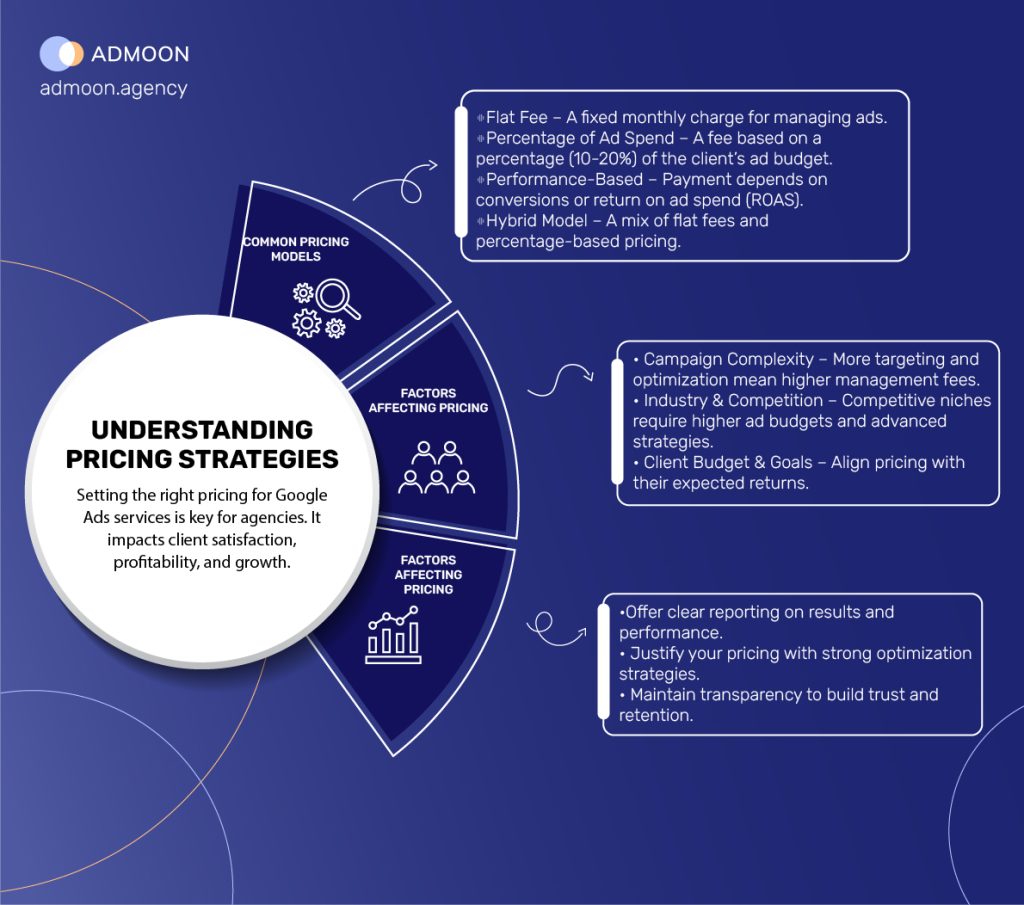
Percentage of Ad Spend Model Explained
Google Ads agencies often use the percentage of ad spend model. This model charges a set percentage of the client’s total ad budget. The client spends this on their Google Ads company.
Typical Percentage Ranges
This model usually charges between 10-20% of the ad spend. But, some agencies might charge as little as 5% or up to 30%. This depends on the service level, campaign complexity, and other factors.
Advantages and Disadvantages
- Advantages: This model aligns the agency’s interests with the client’s goals. The agency’s revenue grows with the client’s ad performance. It also offers flexibility, as fees adjust with the ad spend.
- Disadvantages: Clients might see the fees as too high, especially for smaller budgets. The agency might not want to lower the ad spend since their income depends on it.
Best Suited Business Types
This model works best for businesses with big ad budgets. As the ad spend grows, the fees become more manageable. It’s great for e-commerce, lead generation, and other businesses that heavily rely on Google Ads for growth.
“The percentage of ad spend model is a popular choice for businesses that want to align their agency’s interests with their own advertising success.”
Fixed Fee Pricing Structure
In the world of Google Ads, the fixed fee pricing is popular. It’s known as “flat rate PPC management” or “fixed-price Google Ads.” It means a set monthly or yearly fee for all services. This gives clients a clear budget for their marketing.
This pricing model is simple. Clients know exactly what they’ll pay for Google Ads management. This helps them budget better and avoid unexpected costs. It’s great for small and medium-sized businesses that need a steady approach to their ads.
With this structure, you get many services like campaign setup and ongoing management. It’s good for businesses without the skills or resources to manage Google Ads themselves. By using a fixed-price Google Ads agency, they can focus on their main business while getting expert flat rate PPC management.
| Advantages | Disadvantages |
| Predictable monthly or annual costs Comprehensive suite of services included Simplifies budgeting and planning Ideal for businesses with limited in-house expertise | Potential for agency to underestimate effort required Less flexibility compared to other pricing models May not align well with high-growth or rapidly changing campaigns |
The fixed fee pricing structure is perfect for those who want predictability and simplicity. It’s great for companies with a stable marketing budget. They get a full, monthly retainer-based solution.
Performance-Based Pricing Models
In the world of pay-for-performance PPC and results-based pricing, new pricing models are popular. These models match a business’s goals with the agency’s incentives. They make sure the agency gets paid based on how well they do.
Commission Structures
One common model is the commission structure. The agency gets a percentage of the ad spend or revenue. This means they work hard to make the campaigns successful, because their pay depends on it.
Goal-Based Compensation
Another model is goal-based compensation. The agency’s pay is tied to reaching specific targets, like a certain return on ad spend. This model pushes the agency to focus on results that help the client’s business grow.
Hybrid Performance Models
Some agencies mix both commission and goal-based models. This way, they balance their pay with the client’s need for clear, results-focused pricing. These Google Ads incentives make sure both sides are committed to success.
Using performance-based pricing models lets businesses get the most out of their pay-for-performance PPC campaigns. They work with agencies that are really motivated to achieve great results-based pricing.
Hourly Rate Model for Google Ads Management
The hourly rate model is a common choice for Google Ads management. It lets clients pay for the time and effort from the PPC consulting agency. This makes it a clear and flexible way to manage PPC consulting rates.
The Google Ads hourly fees can range from $100 to $300 per hour. This depends on the agency’s skills, the campaign’s complexity, and the service level. This model is great for clients with specific projects or who want detailed management of their Google Ads.
- The hourly rate model is good for businesses with small budgets or who want more control over their Google Ads spending.
- It lets clients adjust their PPC management as their needs change, making it flexible for companies with varying advertising needs.
- Hourly rates give a clear view of the agency’s time and effort, which is helpful for businesses that need to explain their marketing costs.
However, there are some downsides to the hourly rate model. Clients might find it hard to predict their costs, as the final bill can vary. Agencies might also not work as hard to improve campaigns, since their pay is based on time, not results.
In summary, the hourly rate model is a good option for businesses looking for a clear and flexible PPC pricing. But, it’s key to consider the agency’s skills, the campaign’s complexity, and the trade-offs in cost predictability and campaign optimization.
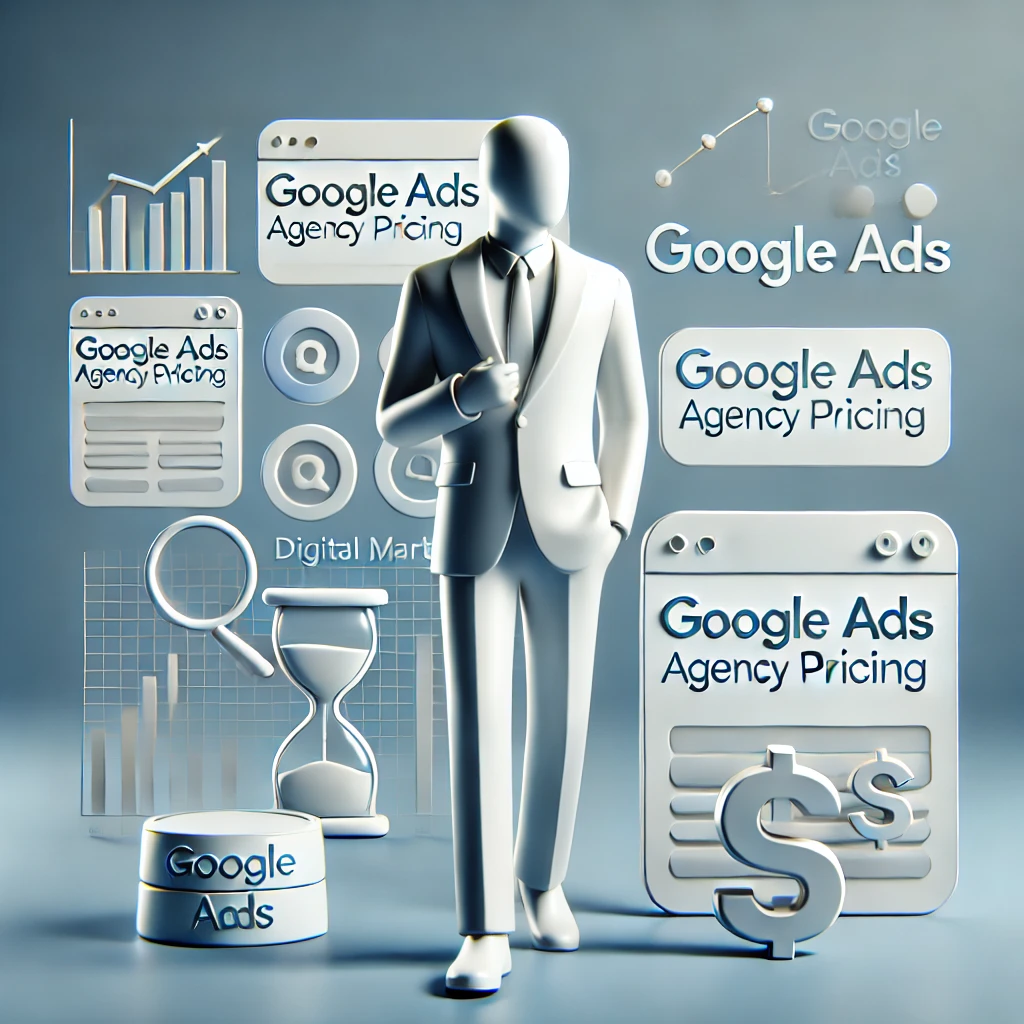
Factors Affecting Agency Pricing
Google Ads agency pricing depends on several key factors. Knowing these can help businesses make better choices. Let’s look at the three main elements that affect PPC management costs.
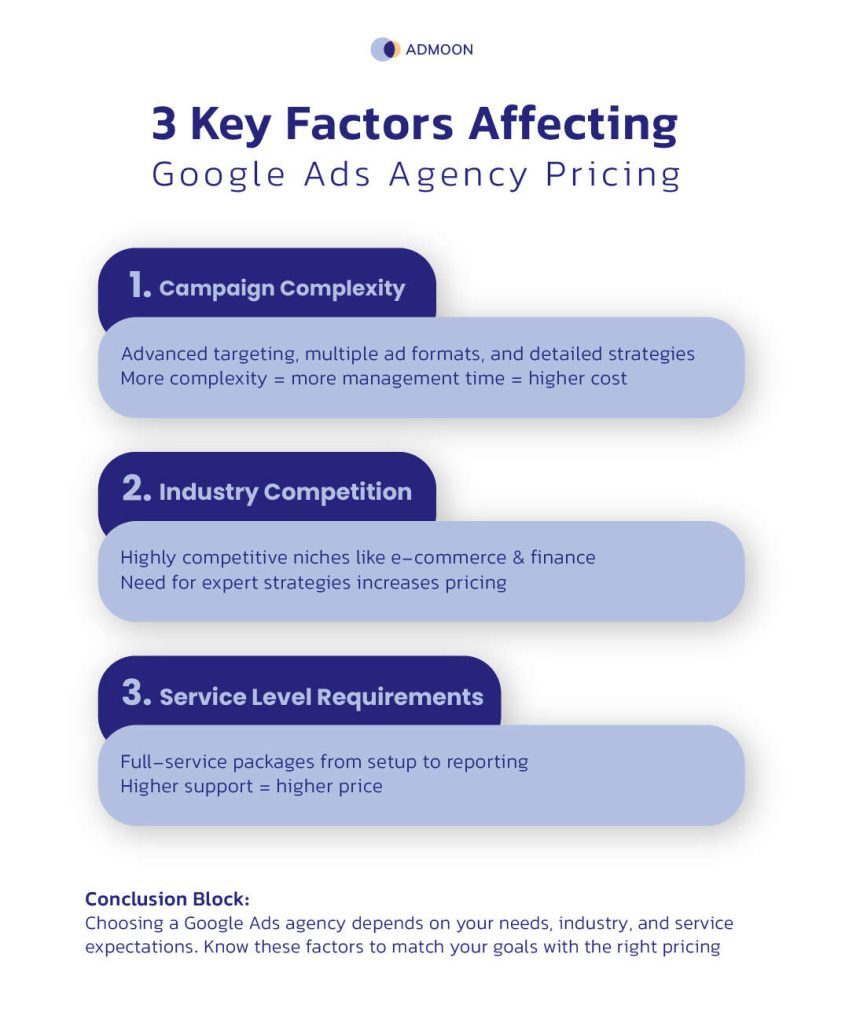
Campaign Complexity
The complexity of a Google Ads campaign is a big factor in pricing. Campaigns with detailed targeting, many ad formats, and complex strategies need more work. Businesses with complex needs might pay more for expert management.
Industry Competition
The competition in an industry can also change pricing. Markets like e-commerce or finance need advanced strategies. Agencies in these areas might charge more for their specialized skills.
Service Level Requirements
The services an agency offers can also impact cost. Businesses needing full-service, from planning to reporting, might pay more. The level of support and communication expected also affects prices.
Understanding these factors helps businesses choose the right Google Ads agency. They can find one that fits their needs and budget.
How to Choose the Right Pricing Model for Your Business
Choosing a PPC agency for your Google Ads is a big decision. You need to know about the different pricing models. The right one can affect your budget and the service you get.
Think about your Google Ads pricing comparison and what you can spend on AdWords management costs. Each model fits different needs and budgets. It’s key to match your goals, resources, and campaign complexity.
Evaluate Your Needs and Budget
- Check how complex your Google Ads campaigns are and how much help you need.
- Figure out your budget and what AdWords management costs you can handle.
- Think about your future growth and how the pricing model will fit with it.
Understand the Pricing Models
- Percentage of ad spend: This model takes a percentage of your ad spend, usually 10% to 20%. It’s good for businesses with changing budgets.
- Fixed fee: You pay a set monthly or yearly fee, no matter the ad spend. It offers stable costs but might not grow with your business.
- Performance-based: The agency gets paid based on their results, like a commission on sales. This model rewards success.
- Hourly rate: You pay by the hour for the agency’s time. It’s clear but might not encourage the best results.
Look closely at each pricing model to find the best fit for your Google Ads pricing comparison, budget, and AdWords management costs. Talk to potential agencies, ask questions, and negotiate to pick the right PPC agency for your business.
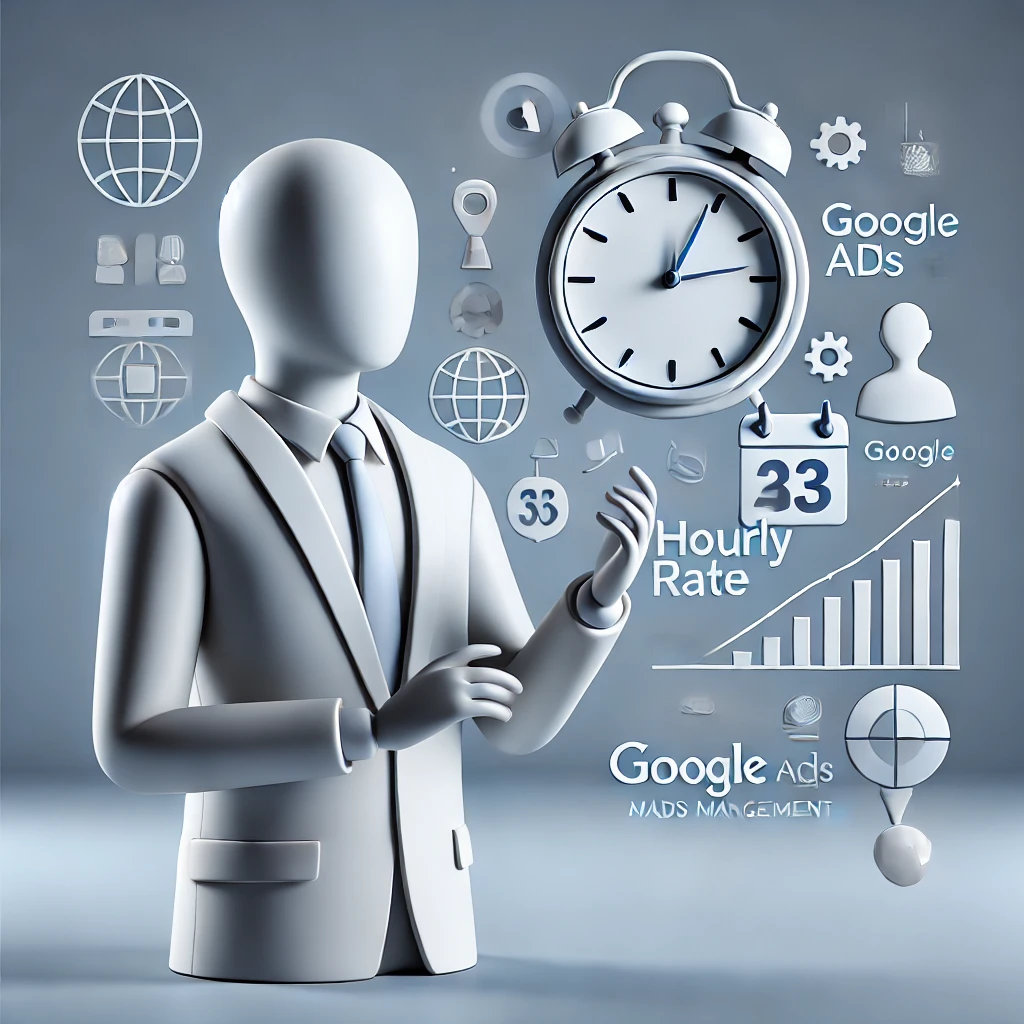
“The right pricing model can make all the difference in the success of your Google Ads campaign. Choose wisely to maximize your return on investment.”
Conclusion
Understanding google ads agency account rent is key for your business’s PPC management. Each model, like percentage-based or fixed-fee, has its own benefits and challenges. It’s important to know what each offers.
Choosing the right Google Ads agency means looking at your business needs, budget, and goals. Consider how complex your campaigns are, the competition in your industry, and what level of service you need. This helps find the best pricing model for your business.
The best Google Ads pricing strategy for you depends on your unique situation and goals. Being well-informed helps you make the right choice. This way, you can fully use Google Ads to grow your business.
FAQs
1)What is the percentage of ad spend pricing model for Google Ads agencies?
This model charges a percentage of your ad spend. It usually ranges from 10% to 20%. The higher rates are for smaller budgets.
2)How do fixed-fee pricing structures work for Google Ads management?
With this model, you pay a set fee each month or year. It’s good for those with steady budgets. It makes costs clear and predictable.
3)What are the benefits of performance-based pricing models for Google Ads management?
These models reward the agency for your success. They earn a share of your revenue or conversions. This motivates them to do their best.
4)How does the hourly rate model work for Google Ads management?
You pay by the hour for their work. It’s best for complex or custom campaigns. This way, you only pay for the time they spend on your ads.
5)What factors influence Google Ads agency pricing?
Pricing changes based on campaign complexity and industry competition. It also depends on your specific needs. Agencies adjust prices to meet your unique requirements .
6)How can businesses choose the right pricing model for their Google Ads management needs?
Think about your budget, goals, and service needs. Knowing the different models helps you choose the best one for your business.


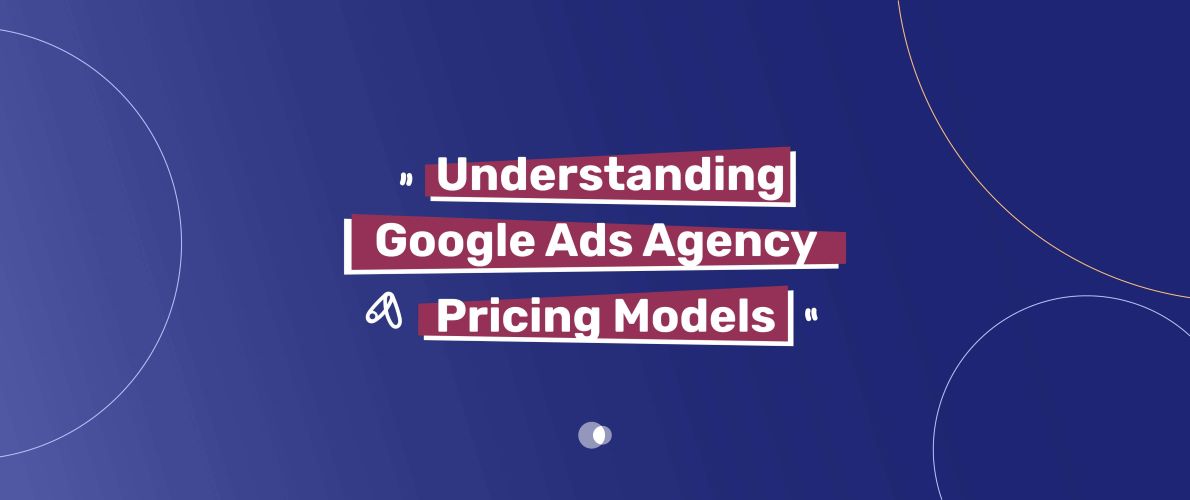

So Useful about google ads pricing models